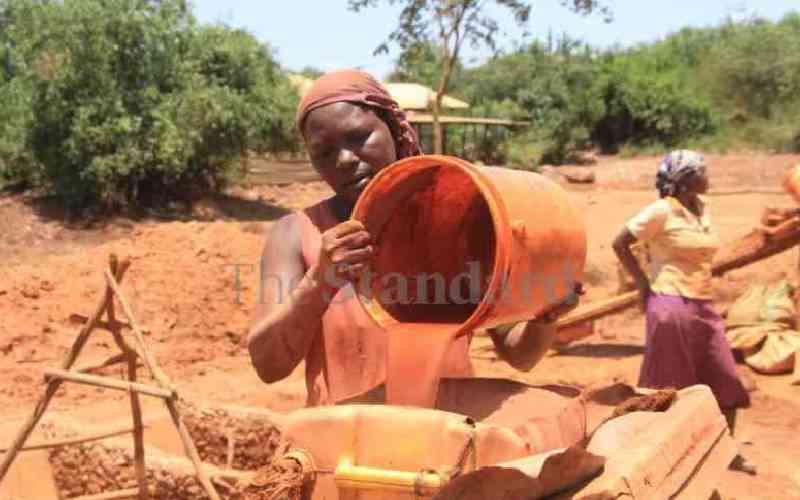The leather sector in Kenya is a potential economic cash cow. But for the sector to thrive, we need to add value to the raw hides and skins available in abundant quantities locally. We have to start exporting footwear and other valuable leather products.
Besides the much-needed foreign exchange, the leather sub-sector can generate thousands of jobs for our youth and lift many households out of poverty, particularly in the vast arid areas where livestock rearing is the economic mainstay.
Available data shows Kenya enjoys comparative advantage in leather production. Unlike global leather production hubs like India, China, Vietnam and Italy, Kenya has relatively easy access to raw materials.
But the countries I have mentioned invest heavily in value addition, thus generating billions of dollars from finished leather goods such as footwear, handbags and belts, despite the fact that they import most of the hide they consume.
Eighty-nine per cent of Kenya's leather exports comprise wet blue, industry parlance for unprocessed or raw leather.
This translates roughly to Sh10 billion, compared to Sh500 million in finished leather products. Yet, 63 per cent of the total work-force in the leather industry is employed in the informal sector.
Fully processed leather has ten times more value than unprocessed hide. This means that a piece of raw hide sold for one hundred shillings has a value of five thousand shillings when converted into footwear, belts, handbags and other leather accessories.
The competitiveness of the sector lags significantly behind our global competitors. The World Bank has identified the competitiveness constraints as lack of quality hides and skins, costly and low quality manufacturing processes and lack of industry coordination. I will delve into each of these factors:
First is the poor quality of our raw hides. Most of our hides are extracted from animals using rudimentary tools like knives, leading to a serious deterioration in value. As such, they cannot be used to manufacture high quality leather items that would fetch higher prices.
Second is the high cost of putting up leather industries; the average plant requires hundreds of millions of shillings to put up. Leather production is an environmentally sensitive process requiring huge investment in effluent treatment plants.
This, coupled with low access to financing for expansion, has effectively shut out local small and medium investors, thus stifling the growth of the industry.
Third; limited vertical linkages from raw hide to tanneries to finished goods work heavily against the local leather industry. Farmers are forced to sell their hides to unscrupulous middlemen who have the upper hand and who then export these to foreign markets. As I have already alluded to here, this denies local producers and the country an opportunity to earn more from the commodity.
Fourth, the skills required to transform our leather beyond wet blue is limited, not to mention the high cost of labour. All these factors conspire to make the cost of producing high value leather goods in Kenya high. Compared to Ethiopia which is our closest competitor, the cost of production if thirty per cent higher in Kenya.
On the flip side of this challenging landscape is a huge opportunity in the global market. Over 85 per cent of the global leather industry is footwear. Two-thirds of global leather products are consumed in the United States and Germany.
Under the Africa Growth Opportunity Act (Agoa) and European Union legislation, Kenyan goods enter these two markets duty-free. So, investors in our leather industry should not only target the local and regional markets but also prime markets such as the US and European countries.
Stay informed. Subscribe to our newsletter
The question then becomes, what is the government doing to promote the local leather industry?
Working with stakeholders, the Government through the Ministry of Industrialisation and Enterprise Development has rolled out several interventions to make Kenya's leather industry globally competitive.
These include improving the quality of locally produced hide, for instance, by educating farmers and slaughter-house operators on using better methods of treating raw hide.
These measures, of course, will yield little if we do nothing to curb the proliferation of second-hand imported leather products popularly known as 'mitumba'. For instance, over 63 per cent of the shoes worn in Kenya or 26 million pairs bought per year are mitumba. Only 3.3 million pairs or 22 per cent of shoes bought are made of pure Kenyan leather.
We are exploring a dual-pronged policy intervention; developing the local leather production capacity while restricting importation of mitumba leather products.
 The Standard Group Plc is a
multi-media organization with investments in media platforms spanning newspaper
print operations, television, radio broadcasting, digital and online services. The
Standard Group is recognized as a leading multi-media house in Kenya with a key
influence in matters of national and international interest.
The Standard Group Plc is a
multi-media organization with investments in media platforms spanning newspaper
print operations, television, radio broadcasting, digital and online services. The
Standard Group is recognized as a leading multi-media house in Kenya with a key
influence in matters of national and international interest.
 The Standard Group Plc is a
multi-media organization with investments in media platforms spanning newspaper
print operations, television, radio broadcasting, digital and online services. The
Standard Group is recognized as a leading multi-media house in Kenya with a key
influence in matters of national and international interest.
The Standard Group Plc is a
multi-media organization with investments in media platforms spanning newspaper
print operations, television, radio broadcasting, digital and online services. The
Standard Group is recognized as a leading multi-media house in Kenya with a key
influence in matters of national and international interest.









